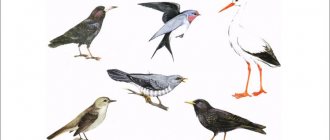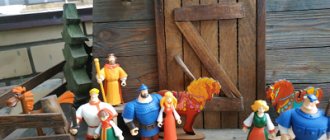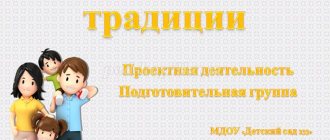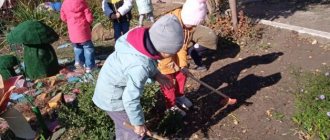Project “My Favorite City” (preparatory group)
Goal: - encourage children to speak out; — test children’s knowledge of city
, your home address.
2. Cognitive - research. Drawing up a map of the street where our kindergarten is located.
2) Independent activity of children. Looking at a map - city
(check the boxes for the most interesting places
in the city
, places where the children have already been).
3) GCD. Design “The area in which our kindergarten is located”
.
Goals: - expand and clarify children’s ideas about the area in which their kindergarten is located; – learn to work collectively, discuss details of work; - develop imagination.
Afternoon.
1) Role-playing game “Streets of my hometown ”
.
Goal: - to help children divide the group
into supposed streets with different play centers organized on them
(hospital, store, pharmacy, police, post office, kindergarten)
;
- develop free communication with adults and children during the game
2) D/i “Lay down a monument”
.
The first half of the day
1) Group/subgroup activities
:
1. Children’s story about interesting places in the city
, where they have already visited.
2. CHHL. Reading poems about your hometown
.
2) Independent activity of children. Looking at books and photographs.
3) GCD. Cognition: “The history of the emergence of our native city ”
.
Goals: - consolidate children’s knowledge about their hometown
;
— introduce the history of the city and its founder
; - cultivate interest in the history of their native land.
Afternoon.
1) Educational - research “Compilation of the Red Data Book of the native land”
.
Purpose: - storytelling, showing illustrations of animals living in our area.
2) Conversation: “What interesting things did you see and remember when visiting the museum?”
3) Drawing on the theme “Animals of our native land”
.
4) Work with parents: offer to find information about the number of streets in the city
and whose names the streets are named after.
Day 5
The first half of the day
1) Group/subgroup activities
:
Compiling and guessing riddles on the topic “My favorite places in my city ”
.
2) Independent activity of children.
Cognitive - research. Looking at illustrations of industrial facilities in our city
.
Afternoon.
1) Educational fairy tale. Goal: - listening to fairy tales and memorizing small genres of oral - folk art from the collection “In a Certain Kingdom”
.
2) Productive. Making the album “My City ”
.
3) D/i “Guess where I am”
.
Project result
:
Knowledge gained during the project
, helped to increase the importance of patriotic education of children and the formation of patriotic feelings among preschoolers.
Parents and educators were convinced of how relevant the topic of studying one’s hometown is
.
The project
interested children and adults, united parents and children in raising future citizens of their
city and country
.
Pedagogical project “Hometown” (group, creative, short-term)
Just like a small tree that barely rises above the ground, a caring gardener strengthens the root, on the power of which the life of the plant depends for several decades, so a teacher should take care of instilling in his children a feeling of boundless love for the Motherland.
V. A. Sukhomlinsky
Love for one’s homeland, understanding of the uniqueness and richness of cultural traditions play a huge role in the development of a child’s personality. It is impossible to instill self-esteem and self-confidence in children without respect for the history of their Fatherland. A small child does not yet understand political or socio-economic contradictions and disputes. It is important for him to love his family, his hometown, be friends with his peers, and be proud of his homeland.
What is patriotism? At different times, many famous people of our country tried to give a definition. Thus, S.I. Ozhegov defined patriotism as “... devotion and love for one’s Fatherland and one’s people.” G. Baklanov wrote that this is “...not valor, not a profession, but a natural human feeling.” Recently, the term “new patriotism” has appeared, which includes a sense of responsibility to society, a feeling of deep spiritual attachment to family, home, Motherland, native nature, and a tolerant attitude towards other people.
You need to start working on patriotic education by cultivating a sense of attachment to your family, your native kindergarten, your native street, your city - that is where the formation of the foundation begins, on which a more complex education will grow - a feeling of love for your Fatherland.
The factor of developmental deviations in children of the OPD group, which manifest themselves to varying degrees, forces us to be especially attentive to the work of familiarizing each child with the environment and developing the speech. This was the reason for creating this project. In children with severe speech impairments, there is underdevelopment of all cognitive activities (perception, memory, thinking, speech), especially at the level of volition and awareness. The attention of these children is characterized by instability, difficulties of inclusion, switching and distribution. This category of children experiences a narrowing of memory capacity, rapid forgetting of material, especially verbal, and a decrease in active focus in the process of remembering a sequence of events. Many of them are characterized by underdevelopment of mental operations, a decrease in the ability to abstract and generalize. Children with SLD are more easily able to assimilate material presented visually. Based on the developmental characteristics of preschoolers with ODD, we can conclude that they need specially organized activities to get to know their hometown under the guidance of an adult.
Project goal : Introducing children to their hometown
Tasks:
1. Accumulate social experience of children’s life in their city.
2. Give children local history information about their hometown, the history of its origin, its attractions, industry, modes of transport, city buildings and institutions, people’s labor activities, and famous fellow countrymen.
3. To form a personal attitude towards facts, events, phenomena in the life of the city, to create conditions for the active involvement of children in social reality.
4. Cultivate pride in your small homeland, the desire to make it better.
5. Learn to answer questions with complete answers, using new words in speech related to the history and life of the city.
Project participants : children of senior preschool age with special needs, group teachers, parents of pupils, pre-school specialists.
Project implementation.
| Program section | Forms and methods of work |
| Play activity | Educational games and exercises: “Where is the monument”, “Find out by description”, “Experts of Severodvinsk”, “Who can choose the most words”, “Continue”, “It happens”, “Is everything right? Prove it!”, “Severodvinsk riddles”, “Loto: how much of what?”, “Find what you need”, “Professions of the city”, “Graphic dictation”, “Find the mistake”, “Who is faster?”, “What is this?”. Creative assignments: “My House”, “City Streets”, “The City of Severodvinsk” Role-playing games: “Family”, “Hospital”, “Clinic”, “Shop”, “Theater”, “City Travel”, “School”, “Kindergarten”, “Construction”, etc. Theatrical activities “In the theater”, “Sea game”. “Playing in the profession”, “In the yard”, play on E. Moshkovskaya’s “Fun Shop”, table theater “Who Lives in the House?” |
| Cognitive - speech development | Conversations, excursions, observations, targeted walks, classes. (for forward planning see appendix) |
| Familiarization with fiction. | Reading and discussion of poems by A. Ryazantsev, G. Zaikin “Our Northern City”, V. Matveev “Motherland - Russia”, V. Semern “North, North...”, G. Bezdolny “Near the White Sea”, c. Kulyakov “Northern Dvina”, N. Sosnin “We live in the north”, N. Kalinina “How the guys crossed the street”, S. Marshak “Policeman”, B. Zhitkov “What I saw” (fragments), M. Pozharova “Painters” ", S. Marshak "Mail", D. Rodari in the lane. S. Marshak “What do crafts smell like?”, K. Ushinsky “Baker”, S. Baruzdin “Who built this house?”, “Architect”, “Bricklayer”, “Painter”, “Carpenter”, V. Mayakovsky “This is a worker ", "Who to be?", V. Oseeva “With Your Own Hands”, A. Barto “Glory to Our Motherland”, K. Ushinsky “How They Build Houses”, E. Permyak “What Are Hands For”, S. Marshak “Mail”, I. Turichin “A Man Sick”, Katerina , Nefyodova “House. What is he like?”, T. A. Shorygina “Professions. What are they?”, V. P. Gudimov “Thematic riddles”. Memorizing the poem “My City” by E. Lystsov, L. Penkin. Reading excerpts and essays about the first builders of the city. |
| Productive activity. | Drawing: “My House”, “City Streets”, “Theatre”, “By the White Cold Sea”, “Golden Autumn in the City”, “Decorated Christmas tree in our hall”, “City of Sailors”, “My Dream House” Application: “Theater”, “Houses are different”, “City of the future”, “By the Cold White Sea” (non-traditional technique) Projects: “Street of our city”, “Construction” Promotion: “The greenest city” Construction and manual labor: “Different houses”, “Road signs”, “Transport”, “Sailors”, “Trees” (twisted foil), “North star” (isothread) |
| Musical development | “If you went on a journey with a friend...” (Music by V. Shainsky) “Big Round Dance” (music by B. Savelyev, lyrics by A. Khait) |
| Working with parents | – Conversations about the importance of this problem. – Questionnaire “My city Severodvinsk”. – Folder – moving “Where does the Motherland begin?” – Photo exhibition “My Favorite Places”. – Joint production of the book “I live in the city of Severodvinsk” by parents and children of the group. – “An Evening of Memories” (stories from parents and grandparents about the construction of the city, about their work). – Participation of parents in enriching the subject-developmental environment of the group on this topic. – Landscaping of the kindergarten site, equipping it with buildings. – Weekend club “Hike to the seashore”, “To the museum”. |
Children were introduced to their hometown according to the following stages of knowledge:
- house,
- Street,
- microdistrict,
- city.
For each month, we have drawn up a long-term plan for the stages of work, providing for the inclusion of all types of activities of preschoolers. Particular attention was paid to enriching and expanding children's knowledge about their hometown through specially organized activities: classes (“Severodvinsk - the city of the North”, “Our street”, “How does transport help us?”, “Who built this house?”, etc. .); excursions (to the city local history museum, to a construction site, to a monument); targeted walks (school park, to a traffic light, along city streets, to a parking lot, to the sea); observations (of the nature of the northern region, transport, city residents, birds, etc.). The acquired knowledge was consolidated through play activities (role-playing and didactic games), theatrical activities (playing out fairy tales), as well as productive, specially organized and independent activities of children (drawing “The House of My Dreams”, “City Streets” and others, application “ Theatre”, “City of the Future”, construction “Transport”, “Sailors”, etc.).
Of particular interest to children and the greatest emotional response were excursions to a museum, studio, store, post office (parent’s place of work), during which preschoolers can become more closely acquainted with representatives of different professions, their actions, and tools.
The children reflected their impressions in games that they organized in the evening. In the group, the boys began the construction of new houses: they brought bricks and cranes in cars, and built houses; worked on a warship as sailors. Girls preferred games such as “Shop”, “Mail”, “Home”, “Kindergarten”, etc.
In order for the children’s knowledge to be deep and lasting, we turned to parents for help, to whom we explained the importance of working to familiarize preschool children with their hometown. However, many mothers and fathers cannot always correctly formulate a question in a conversation with a child; their stories can be complex, oversaturated with special terms and details (not adapted to the child’s age), so we have created a folder for parents - the “Where does the Motherland Begin?” The parents showed creativity and resourcefulness when they jointly produced a book with their children on the topic “I live in the city of Severodvinsk.” The “Evening of Memories” created a special, confidential and warm atmosphere, where parents and grandparents shared memories of the construction of the city over a cup of tea. The photo exhibition “My Favorite Places” we designed sparked a heated discussion among parents and children of a group of favorite places in the city.
Thus, getting to know the hometown through a variety of activities made it possible to create a diverse, unique environment that influenced the imagination and formed the child’s individual attitude towards his small Motherland - the city of Severodvinsk. Thanks to the work done, the child not only learned about his city, but also responded to the events of the surrounding world (holidays, cultural events), and expressed his attitude towards them.
Innovative project on patriotic education “My City” for the senior group
Tamara Kuzhataeva
Innovative project on patriotic education “My City” for the senior group
PROJECT “MY CITY ” IN THE SENIOR GROUP .
Project type : open, research, short-term. It is carried out inside the preschool educational institution in contact with the families of the pupils .
Project participants : senior , teachers , parents.
Implementation period: short-term (two weeks)
– 02.10.17 – 13.10.17
Relevance of the project :
An integral part of any education system is the education of patriotism . Patriotism is love and affection for the Motherland, devotion to it, responsibility for it, the desire to work for its benefit, to protect and increase wealth. Love for the Fatherland begins with love for one’s small homeland - the place where a person was born. Of great importance for the cognitive, social, personal and moral development of preschool children is familiarity with their hometown , its attractions, the street on which the child lives, with famous people who built our city . Parents have insufficient knowledge about their city , do not pay attention to this problem, considering it unimportant, children do not have sufficient information about their hometown .
We strive to make the city in which the children live a favorite one!
Novelty of the innovative project
The novelty of the project is that preschool children have very little life experience. Despite this, we consider it possible and necessary to introduce children to the history of their hometown , to form feelings of patriotism , basic ideas about the people, customs, history, and culture.
project work system opens up wide scope for innovation . And in order to achieve a certain result, it is necessary to find unconventional methods of influencing a child that would not seem boring to the child, or overly edifying, but would naturally and harmoniously fill his worldview with content in project activities .
Practical significance: Using this project to exchange work experience among teachers. Improving interaction with parents.
Hypothesis We believe that the use of this project (a model of educational technology for design and research activities of pupils of the 6th year of life ) will lead to the activation of the mechanism of children's self-development, as a result of which the cognitive initiative, social and creative activity of preschoolers will move to a qualitatively new level.
If children study the topic of patriotic education through project activities , then an integrated approach to raising children in the spirit of patriotism , that is, preschoolers will be introduced to the history and culture of their native land, local attractions, love and respect will be brought up , as well as attachment to their small homeland.
Goal: To form the primary ideas of children of senior preschool age about their hometown .
Project objectives :
— development of children’s cognitive activity, increasing interest in the history and culture of our city , developing a sense of patriotism ;
- nurturing love for the Fatherland , the city in which we live, pride in its culture,
- formation of interest in collective, playful, productive, creative activities.
MAGAZINE Preschooler.RF
Senior group project “My City”Relevance of the project:
Fostering love and respect for one’s hometown is the most important component of moral and patriotic education.
To raise patriots of your city, you need to know it.
Patriotism is love and affection for the Motherland, devotion to it, responsibility for it, the desire to work for its benefit, to protect and increase wealth.
The foundations of patriotism begin to form in preschool age. The foundation of patriotism is rightfully considered to be the purposeful familiarization of children with their native land.
Children are our future, and therefore the future of our country. Each of us must love our country. You need to start cultivating love for your homeland small. With love for your city.
Project type: creative, information and research, long-term
Type of project: family, group.
Problem: Children know the name of the city, home address, look at photographs about their hometown with enthusiasm, and share their impressions. But, talking with them, I became convinced that they lack knowledge about the history of the emergence of their native city, about its symbolism. Parents do not tell their children about the history of the city or introduce it to its sights.
Expected results: children have basic knowledge about the history of their hometown, can talk about interesting, historical places of their small homeland, and have experience in joint activities with their parents.
Dates: September – November 2022
Children's age: preparatory group
The goal of the project: to create conditions for the development of patriotic feelings in children, to increase the active participation of parents in the life of the group.
Tasks:
to cultivate in children a love for their hometown, to form in children an initial understanding of the history of their hometown, its attractions, to expand children’s horizons and vocabulary,
develop patriotic feelings in children, continue to work on the development of children's creative abilities.
Project participants: children of the senior preschool city, teachers, parents.
Expected result:
The children developed a sense of pride in their city, in the people who participated in its creation, and in its unique beauty.
Educational value:
Children and parents became interested in the historical past of our city, active in searching for local history material, and interested in the unique nature of their native land.
Mental Value:
The scope of children’s knowledge about the history of their hometown has expanded and systematized.
Preliminary work:
Formulation of goals and objectives.
Studying methodological literature
Creating a developmental environment
Selection of games and equipment
Creating conditions for artistic and productive activities
Stage 1 - preparatory
- Select the necessary literature, illustrations, and materials for children’s play activities for the successful implementation of the project.
- To interest children and parents in the topic of the project, to encourage them to work together aimed at achieving the goal of the project.
- Create the necessary basis for children’s productive and creative activities.
- Draw up a long-term action plan.
- stage. Project implementation.
Organization of project activities.
3. 1 The history of the origin of the native city.
Goal: To arouse interest and desire to learn about the history of your city. Form cognitive interests, curiosity, activity. Cultivate love for your hometown.
3. 2 Game activity.
- ** Didactic game "Building a house"
Goal: continue to teach everyone how to play together and how to have friendly relationships with peers.
- ** Printed board game “City” , lotto “Professions”
Goal: to cultivate love and respect for the people around us, broaden their horizons and enrich children’s vocabulary with new terms, and develop coherent speech.
- ** Word games “The path is the road” , “Say a word” , “You tell me - I tell you” .
Goal: to expand children’s knowledge about the streets of the city, teach them to pronounce correctly, continue to develop the ability to listen and hear the interlocutor, develop speech, memory, and imaginative thinking.
3. 3 Speech development:
Goal: to form in children the concept of “small homeland” , expand their vocabulary, cultivate love for their native land, cultivate a caring attitude towards the surrounding nature, teach them to carefully observe and listen, develop speech and memory.
- Reading poetry and short stories.
- Conversation: “Who lives where?” , “Where you were born, that’s where you came in handy” , “How can I help my hometown?” , “Attractions of the native city” , “Streets and nooks and crannies.
- Reading proverbs and sayings about the homeland, riddles.
- Musical and theatrical activities.
Goal: learn to listen, improvise, develop rhythmic movements, learn to fit the chosen role.
3. 4. Artistic and aesthetic development:
Goal: to develop children's creative abilities, instill accuracy in work, and cultivate a love of work.
Making works from plasticine “Blooming Tree”
3. 5. Photo exhibitions “Nature of the native land”
Goal: to cultivate patriotic feelings, a sense of pride in their native land, to teach them to see beauty in simple things.
3. 6. Productive activity.
— Drawing: “My house”
— Applications: “City Streets”
3. 7.Working with parents:
Consultation “Introducing children to their hometown .
Making models of “Buildings of our city”
Product of project activity.
4. Photo exhibition in the group “Sights of our city” .
| Next > |






